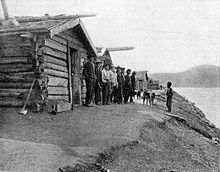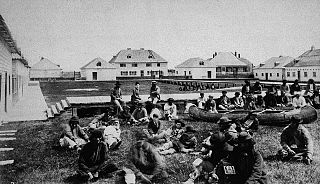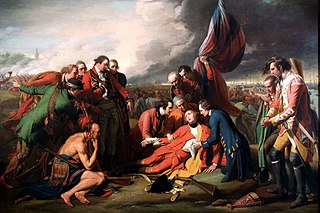

Fort Selkirk is a former trading post on the Yukon River at the confluence of the Pelly River in Canada's Yukon. For many years it was home to the Selkirk First Nation (Northern Tutchone).


Fort Selkirk is a former trading post on the Yukon River at the confluence of the Pelly River in Canada's Yukon. For many years it was home to the Selkirk First Nation (Northern Tutchone).
On February 3, 1947, a temperature of –65 °C (–85 °F) was recorded in Fort Selkirk, which would’ve been considered the coldest temperature in North America. However, the thermometer that was used was placed on the outside wall of a building instead of a standard instrument shelter, so the record was disqualified.
The coldest official temperature recorded in Fort Selkirk was –60 °C (–76 °F) on February 3 and 4, 1968 at the Pelly Ranch Farm.

Archaeological evidence shows that the site has been in use for at least 8,000 years.
Robert Campbell established a Hudson's Bay Company trading post nearby in 1848. In early 1852, he moved the post to its current location. Resenting the interference of the Hudson's Bay Company with their traditional trade with interior Athabaskan First Nations, Chilkat Tlingit First Nation warriors attacked and looted the post that summer on Saturday, August 21, 1852.
The fort was rebuilt about 40 years later and became an important supply point along the Yukon River. At age 28, under the command of Inspector John Douglas Moodie, Francis Joseph Fitzgerald was the first person of European descent to chart an overland route from Edmonton to Fort Selkirk, Yukon via northern British Columbia and the Pelly River (1897). The voyage took eleven months, having covered about 1,000 miles. As a result of this achievement, Fitzgerald was promoted corporal in 1899. [1]
Fort Selkirk was essentially abandoned by the mid-1950s after the Klondike Highway bypassed it and Yukon River traffic died down.
Many of the buildings have been restored and the Fort Selkirk Historic Site is owned and managed jointly by the Selkirk First Nation and the Yukon Government's Department of Tourism and Culture. There is no road access. Most visitors get there by boat, though there is an airstrip, Fort Selkirk Aerodrome, at the site.

Northern Canada, colloquially the North or the Territories, is the vast northernmost region of Canada, variously defined by geography and politics. Politically, the term refers to the three territories of Canada: Yukon, Northwest Territories and Nunavut. This area covers about 48 per cent of Canada's total land area, but has less than 0.5 per cent of Canada's population.

Fort Yukon is a city in the Yukon-Koyukuk Census Area in the U.S. state of Alaska, straddling the Arctic Circle. The population, predominantly Gwich'in Alaska Natives, was 428 at the 2020 census, down from 595 in 2000.

Fort Smith is a town in the South Slave Region of the Northwest Territories (NWT), Canada. It is located in the southeastern portion of the Northwest Territories, on the Slave River and adjacent to the Alberta border along the 60th parallel north.

Fort Douglas was the Selkirk Settlement fort and the first fort associated with the Hudson's Bay Company near the confluence of the Red and Assiniboine rivers in today's city of Winnipeg.

The Pelly River is a river in Canada, and is a headstream of the Yukon River. The river originates west of the Mackenzie Mountains and flows 530 km (330 mi) through south-central Yukon. The Pelly has two main tributaries, the Ross and Macmillan rivers.

Robert Campbell was a Hudson's Bay Company fur trader and explorer. He explored a large part of the southern Yukon and northern British Columbia. He established the short-lived Dease Lake Post, and in 1838 he was the first European to reach the Stikine River overland. He established Fort Frances, Yukon on Frances Lake in the Liard River basin. In 1840 he crossed from Frances Lake to the Pelly River becoming the first European to explore the upper Yukon River Basin. He established Fort Selkirk, Yukon, at the juncture of the Yukon River and the Pelly River.

The Selkirk First Nation (Hucha Hudan people) is a First Nation self-government in the Canadian territory, Yukon. Its original population centre was the trading post of Fort Selkirk, Yukon along the Yukon River, but most of its citizens now live in Pelly Crossing, Yukon where the Klondike Highway crosses the Pelly River. The language originally spoken by the Selkirk people was Northern Tutchone. There is a great effort to preserve the language and culture, as can be seen by the popularity of the Selkirk "Keeper of the Songs", Jerry Alfred.
The Northern Tutchone, or Dän k'í, is an Athabaskan-speaking First Nation who primarily lived in the central Yukon in Western Canada.
Pelly Crossing is a community in Yukon, Canada. It lies where the Klondike Highway crosses the Pelly River.

Fort Vermilion is a hamlet on the Peace River in northern Alberta, Canada, within Mackenzie County.

Fort McPherson is a hamlet located in the Inuvik Region of the Northwest Territories, Canada. It is located on the east bank of the Peel River and is 121 km (75 mi) south of Inuvik on the Dempster Highway.

Norway House is a population centre of over 5,000 people, some 30 km (19 mi) north of Lake Winnipeg, on the bank of the eastern channel of Nelson River, in the province of Manitoba, Canada. The population centre shares the name Norway House with the northern community of Norway House and Norway House 17, a First Nation reserve of the Norway House Cree Nation. Thus, Norway House has both a Chief and a Mayor.

The history of the Yukon covers the period from the arrival of Paleo-Indians through the Beringia land bridge approximately 20,000 years ago. In the 18th century, Russian explorers began to trade with the First Nations people along the Alaskan coast, and later established trade networks extending into Yukon. By the 19th century, traders from the Hudson's Bay Company were also active in the region. The region was administered as a part of the North-Western Territory until 1870, when the United Kingdom transferred the territory to Canada and it became the North-West Territories.

Fort Pelly was a Hudson's Bay Company fur trading post located in the Canadian province of Saskatchewan. The fort was named after Sir John Pelly, governor of the Hudson's Bay Company. The current village of Pelly, Saskatchewan, takes its name from the fort, and is located approximately 8 miles north of the site of the fort.
Touchwood Hills Post Provincial Park is the location of a former Hudson's Bay Company (HBC) fur trading post that existed from 1879 to 1909 in the Touchwood Uplands of the Canadian province of Saskatchewan. In 1986, the site was designated a provincial park. It is located along Highway 15 in the RM of Kellross No. 247, about 10 kilometres (6.2 mi) west of Lestock and 16 kilometres (9.9 mi) east of Punnichy.
The Smith River is a river in the Yukon Territory and the province of British Columbia, Canada, arising in the Yukon at 60°09′N126°18′W and crossing the border to enter British Columbia at 60°00′00″N126°23′25″W to its confluence with the Liard River at 59°33′00″N126°29′00″W, between the confluences of the Toad and Coal Rivers. At the confluence is the site of the former Hudson's Bay Company trading post, Fort Halkett, and also Smith River Falls, which are jointly protected by Smith River Falls-Fort Halkett Provincial Park.
Arthur Harper (1835–1897) was an Irish-born Yukon River prospector, trader, and explorer, recognized as the first man to enter the Yukon country seeking gold. He mined in California during the 1850s, and British Columbia during the 1860s, before travelling to the Yukon region in 1871. He reached Fort Yukon in 1873, and managed a store with Jack McQuesten at the Fortymile River. Harper formed a trading partnership with McQuesten and Captain Al Mayo; their company founded Fort Reliance in 1875 and other posts in the Yukon region. Harper was known as the best prospector of the trio, and while he did not achieve major success in his pursuit of gold, he sometimes directed others to finds. He traded and prospected in Alaska until just before his death.

The Indigenous peoples of Yukon are ethnic groups who, prior to European contact, occupied the former countries now collectively known as Yukon. While most First Nations in the Canadian territory are a part of the wider Dene Nation, there are Tlingit and Métis nations that blend into the wider spectrum of indigeneity across Canada. Traditionally hunter-gatherers, indigenous peoples and their associated nations retain close connections to the land, the rivers and the seasons of their respective countries or homelands. Their histories are recorded and passed down the generations through oral traditions. European contact and invasion brought many changes to the native cultures of Yukon including land loss and non-traditional governance and education. However, indigenous people in Yukon continue to foster their connections with the land in seasonal wage labour such as fishing and trapping. Today, indigenous groups aim to maintain and develop indigenous languages, traditional or culturally-appropriate forms of education, cultures, spiritualities and indigenous rights.
62°46′N137°23′W / 62.767°N 137.383°W